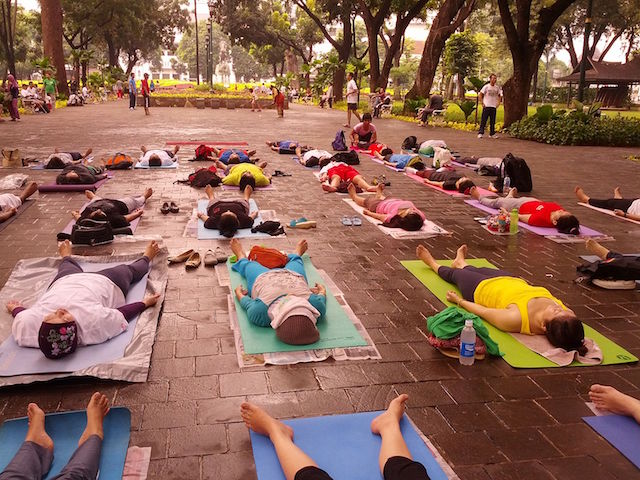Before falling asleep tonight, we can tap into our superpower abilities through Yoga Nidra, or “sleep yoga.”
Research links stress to many chronic health conditions. While many people may be aware of this, they are simply too busy to do anything about it. A Yoga Nidra practice is a highly effective stress manager, and is also used to combat insomnia—and it only takes about 30 minutes a day.
The benefits of a Yoga Nidra practice include: deeper and more restful sleep, promotion of the body’s natural healing process, increased creativity, reduction of stress, enhanced memory and learning capacity and relief from anxiety, depression and many other psychological disorders.
Four steps to practicing Yoga Nidra:
- The first thing we do is lie down on the floor facing the ceiling. This pose is known as Savasana. Allow your arms and legs to spread out in a comfortable position, with eyes closed.
- Okay, here comes the hard part. We now have to commit to not moving throughout the practice, which usually lasts for 30 minutes.
- Next, we have to commit to not falling asleep during this practice. Yoga Nidra may be called sleep yoga, but the point is to actually stay awake and fully aware.
- The last step is to follow the instructions of the teacher. This is an important step because the teacher has to strike the balance between creating a relaxed environment, but also keep the students engaged.
Yoga Nidra Instruction:
The practice will start out with the teacher instructing the students on how to relax by getting them to release and let go of any tension in their muscles. This is accomplished by a technique known as a full body scan.
With the full body scan technique, the teacher instructs us to visualize and to put our attention on a certain body part. This lasts for approximately 10 minutes while we are guided through every major part of our body, going into a deeper state of relaxation each step of the way.
After our body is relaxed, the teacher will ask us to visualize certain objects or symbols in our mind. The point is to stay completely relaxed and aware while following the instructions of the teacher to the best of our ability.
The benefits of practicing Yoga Nidra:
Yoga Nidra engages the body and mind in such a way that we are left feeling strong, rested and invigorated.
The practice of Yoga Nidra activates the parasympathetic nervous system, which promotes the body’s natural healing process.
While in our Yoga Nidra state, we are cultivating a state of consciousness that resides somewhere between being awake and asleep. Our body is totally relaxed as if we are sleeping, but our mind is completely aware and still able to listen to instructions from the teacher.
We actually go into this state of consciousness every night before falling asleep. However, it typically only lasts for 5 to 10 minutes. The brain is emitting alpha waves—the bridge between normal mental activity experienced throughout the day, and sleep—during this state of consciousness.
When we are fully conscious, our brain emits beta brain waves. Beta waves are electrical impulses in the brain cycle between 13 and 30 times per second. Alpha waves cycle between 9 and 14 times per second. The point is, as we relax more deeply these “cycles per second” slow down.
When the brain is emitting alpha waves, as in Yoga Nidra, the parasympathetic nervous system is activated. The parasympathetic nervous system controls bodily functions such as digestion, the immune system, absorption of nutrients and elimination of toxins.
When this system is activated the body is able to heal itself by actively fighting off infections, and effectively expelling waste from the body.
The opposite of the parasympathetic nervous system is the sympathetic nervous system.
The sympathetic nervous system is in charge of the “fight or flight” response. When the body perceives a stressful signal in the environment, the sympathetic nervous system springs into action. The adrenal glands release cortisol and adrenaline into the bloodstream, causing cells to work harder and giving an energy boost to the body in preparation to either run away from danger, or to deal with a threat.
Long term over-activation of the sympathetic nervous system can lead to disease because, among a long list of other reasons, the parasympathetic nervous system is shut down, preventing the body from properly defending itself from bacteria and viruses.
Today, vast numbers of people suffer from an overactive sympathetic nervous system.
The subconscious mind:
Yoga Nidra is one tool that gives us access to our subconscious mind.
Think of the mind like an iceberg. The tip of the iceberg is the conscious mind, the part that is able to look at trees, have conversations, and say things such as, “I love pizza.” The other 90 percent of the iceberg underneath the water represents the subconscious mind.
The subconscious mind holds our deepest core beliefs about the world and about ourselves, which we learned as small children. In a way, everything in our life stems from a belief that resides somewhere within our subconscious mind.
For example, a person who is overweight may subconsciously be holding onto a belief that is creating behaviors that lead to obesity. If you ask them if they’d like to lose weight, they would probably say yes, but this is their conscious mind talking. Deep within their subconscious they may have a belief in place that says “I am an overweight person” or “I am not worthy of being healthy,” or something along these lines.
When in the Yoga Nidra state, there will be a moment after the body is fully relaxed where the instructor will ask us to repeat a “resolve statement.” This is something that we want to create or achieve in our life, and is usually an attempt to change a condition based upon a belief we may not even know we have.
The statement needs to be simple, usually six words or less, and positive. An overweight person could use a resolve statement such as “I am worthy of being healthy.” Other examples of resolve statements are “I have abundance in my life” or “I am creative” or “I have happiness in my life.”
The idea is to repeat this to ourselves as if it were already true, and try to feel in our bodies the sensations associated with this statement being true.
How communicating with the subconscious mind works:
The subconscious mind operates like a computer. It can’t really think for itself, it just takes on commands, similarly to how a computer does when it’s being programmed. This can be seen in small children as they have not yet developed a fully conscious mind, which means their brains are emitting primarily alpha and theta brain waves.
Theta waves are emitted during dreams, as dreams are a manifestation of the subconscious mind. It is like small children are hypnotized because their subconscious mind is completely open and ready to receive new information. This is why they are able to learn so quickly. Children can much more easily become fluent in multiple languages, a task that would take adults many years of intense practice and study to learn. In this way, the child is like a computer with a blank hard drive ready to be programmed.
While in a Yoga Nidra state, our brains are in a similar state of consciousness as that of a small child. The difference is that we still have control of our conscious mind, the part of us that is able to listen to the instructions of the teacher and repeat our resolve statement.
If a simple command is repeated enough by our conscious mind, the subconscious mind will take on the command and believe it to be true in the same way that if told enough times, a child will believe anything. When a person subconsciously believes, “I am worthy of being healthy,” they will actually start to create behaviors in their life to support this belief. This could manifest as eating healthier food or going to the gym.
The point is that the subconscious mind likes to support its beliefs. It likes to be “right,” so it always creates behaviors to support its core beliefs. By changing the beliefs, the behaviors change too.
Conclusion:
As noted, there are abundant benefits that come from practicing Yoga Nidra. Additionally, it’s very easy to incorporate into a busy schedule since it only takes 30 minutes to get the full benefits!
We can practice Yoga Nidra in any space where we will not be disturbed. A great time to practice is just before going to sleep, most people report deeper and better quality of sleep when doing this.
You do not even need to leave the comfort of your own home to learn this technique. I learned it primarily from the book Yoga Nidra, by Swami Satyananda Saraswati. And there are guided Yoga Nidra sessions available on YouTube. I highly recommend listening to recordings so that you can experience being guided by a teacher (though you can certainly be your own teacher).
With the vast amount of studies coming out today linking stress to chronic health conditions, Yoga Nidra is an invaluable asset for those who deal with stress on a day to day basis. But don’t take my word for it, practice Yoga Nidra and activate your super powers today and see how much better you’ll feel!
~
Author: John Miller
Image: Wikimedia Commons
Apprentice Editor: Melanie Jackson; Editor: Emily Bartran









Read 1 comment and reply